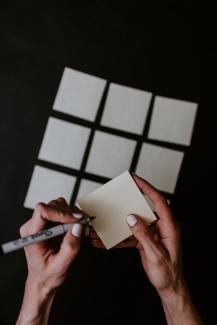
The Silent To-Do List
The New Year using brings on a newfound interest in decluttering and minimalism. Marie Kondo is mainly responsible for bringing this concept mainstream in the United States- in our culture of overconsumption and more and bigger is better. Another voice in the Japanese culture/minimalism movement is Fumio Sasaki. In his book Goodbye, Things, he discusses minimalism and the advantages of adopting this way of life. One of the concepts he coined in his book is the silent to do list and the impact excess clutter has on our mental wellbeing.
The silent to do list refers to the numerous possessions we have in our homes and subsequent clutter that follows, including visual clutter, making it hard to mentally unwind and relax. Visual clutter refers to when there are so many things in one space competing for your eye’s attention that it feels cluttered even when things are put away and clean. Think of multiple items on a kitchen countertop and many bright colors and labels on a shelf. When we have too many things, we see not only the visual clutter it creates but also the visual reminder of all the tasks required to maintain them- the to do list. For example, your items may “tell” you to “clean me”, “move me to the next room”, “finish this project”, “put away this pile of clothing”, etc. Research has linked this to an increase of stress and anxiety in the home- particularly for women and those with ADHD. It creates too much for the brain to take in and process and a never ending to do list of tasks to maintain it all. One of the ways to create a truly relaxing and serene space in your home is to declutter the excess possessions we all have and let your mind rest. This is similar to the feeling of staring out at a vast ocean, open sky, or an open field. You feel the spaciousness and openness of each place and it allows you to do the same in your mind and truly relax and unwind.
How to reduce the silent to do list and declutter:
- Set aside time to intentionally go through each room of your home. You can also sort your items by category, such as clothing or kitchen appliances. One of the tips Sasaki mentions in his book to help you decide what to keep and what to discard is to imagine if you lost the item if you would run out to replace it. If you would, keep it. If not, let it go.
- Pare down. Instead of having a shelf full of random trinkets, pick your top few favorite items to display and discard the rest. Sometimes going from twelve couch cushions or throw pillows to a carefully selected five that go very nicely together is all you need to reduce the visual clutter in any given space.
- Enjoy without owning. Instead of purchasing every single item or appliance you could possibly need for a lifetime, consider borrowing or renting items you use only periodically or seasonally. You can also spend some time window shopping your favorite stores to enjoy certain items without having to own them.
- Pick a simple, calming color palette for your home. This trick has personally helped me so much. Everything neatly flows and coordinates together instead of having a random mix of patterns, colors, and designs all competing for your attention. This is one of the reasons why spas are so relaxing.
- Be intentional. Carefully consider each item you own and each item you purchase. Ask yourself questions like do I really need this? Can I get by without it? Is it adding value to my space or increasing the amount of visual clutter and adding to my silent to do list? Intentionally planning purchases and what to discard is going to be one of your best gatekeepers to your home.
I hope this New Year inspires you to refresh your space and create a calming environment while reducing your silent to do list. If you need a little more inspiration, pick up a copy of Goodbye, Things by Fumio Sasaki or The Life Changing Magic of Tidying Up by Marie Kondo. Happy decluttering!

